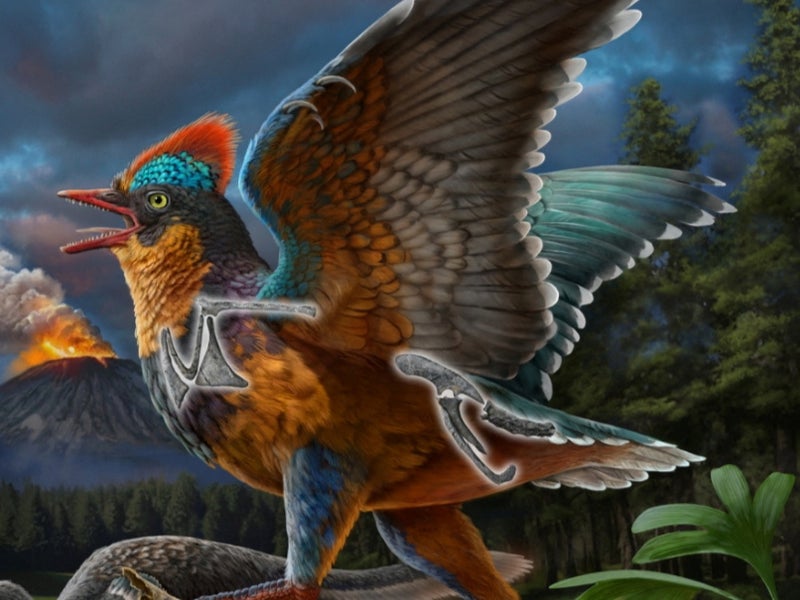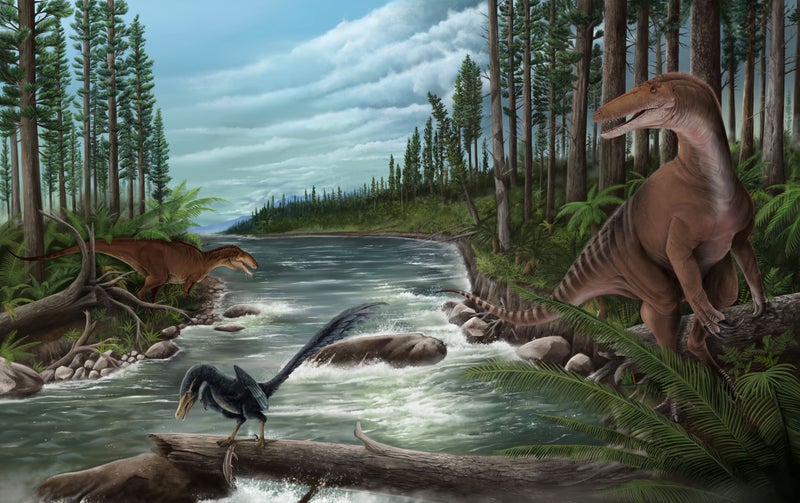Birds evolved from small feathered dinosaurs. A quail-sized bird fossil discovered in southeastern China is reshaping our understanding of avian evolution. The fossil, dating back 150 million years to the Jurassic Period, reveals a surprisingly modern bird for its age. Named Baminornis zhenghensis, this newfound species shares the title of oldest-known bird with Archaeopteryx, discovered in Germany in 1861. However, despite their shared antiquity, Baminornis, measuring about six inches long, exhibits significantly more advanced anatomical features and superior flight capabilities compared to the crow-sized Archaeopteryx, a creature often described as a transitional form between reptiles and birds.
![[A life reconstruction of the Jurassic Period bird Baminornis zhenghensis is seen in this illustration released on February 12, 2025]](https://static.independent.co.uk/2025/02/14/11/SEI239621125-1.jpg)
A key difference lies in their tails. Archaeopteryx possessed a long, bony tail reminiscent of predatory dinosaurs like Velociraptor. Baminornis, on the other hand, sported a shortened tail characteristic of modern birds. This adaptation is crucial for aerodynamics, shifting the body’s center of gravity forward, closer to the wings, and enhancing flight. The stark anatomical contrast between these two earliest-known birds, coupled with their geographical distance – separated by approximately 5,500 miles – suggests that avian evolution had already been underway for millions of years before their emergence. This discovery pushes back the timeline of bird development, highlighting a richer and more complex evolutionary history than previously understood.
Birds evolved from small feathered dinosaurs. Based on the new discovery, the first birds arose 172-164 million years ago, millions of years earlier than previously believed, according to paleontologist Min Wang of the Institute of Vertebrate Paleontology and Paleoanthropology of the Chinese Academy of Sciences, lead author of the study published on Wednesday in the journal Nature. “Baminornis zhenghensis looks more like modern birds than Archaeopteryx,” Wang said, calling its discovery “a landmark to me and other evolutionary biologists.”.
Until now, Archaeopteryx was the only unquestionable bird known from the Jurassic, which ended roughly 145 million years ago. “This fossil (Baminornis) indicates that Jurassic birds probably already had a global distribution and were much more diversified than previously thought,” said paleontologist and study co-author Zhonghe Zhou of the Institute of Vertebrate Paleontology and Paleoanthropology in China.
The Baminornis fossil was discovered in 2023 during scientific fieldwork in Fujian Province’s Zhenghe County. The fossil preserves much of the bird’s skeleton but lacks the skull, leaving a gap in the understanding of its diet and lifestyle that could be interpreted from its jaws and teeth. Wang said Baminornis probably had teeth, as did Archaeopteryx. Until now, the oldest-known birds with short tails lived about 20 million years later than Baminornis, including Eoconfuciusornis, Protopteryx, Cruralispennia and Archaeornithura.
Unlike Archaeopteryx, Baminornis has a pygostyle - a bone plate formed by fused vertebrae at the end of the vertebral column. “A short tail ending with a pygostyle is a universal feature of extant birds. It provides attachment for fan-shaped tail feathers facilitating more sophisticated and powerful flight,” Zhou said. The pectoral and pelvic bones of Baminornis also were more like modern birds than Archaeopteryx. Baminornis did share some primitive characteristics with Archaeopteryx, such as clawed dinosaurian hands.
The researchers found during the same fieldwork a solitary wishbone that was more advanced than that of Archaeopteryx and dating to the same time as Baminornis, but apparently belonging to yet another early bird species. With such incomplete remains, the researchers did not give this apparent new species a name. Baminornis lived in a swampy area alongside the meat-eating dinosaur Fujianvenator as well as various semi-aquatic reptiles, turtles and fish, based on other fossils found in the area.
The 19th century discovery of Archaeopteryx, now known from about a dozen specimens, lent support to British naturalist Charles Darwin’s ideas about evolution and provided evidence that today’s birds descended from dinosaurs. Archaeopteryx was, as University of Edinburgh paleontologist Steve Brusatte put it, “the textbook example of a creature caught in the act of evolution, like a freeze frame.”.
“Yet, for more than 150 years now, Archaeopteryx had stood alone. During all of that time it had remained as the only unquestionable bird fossil from the Jurassic Period,” said Brusatte, who wrote a commentary accompanying the Baminornis study. “Baminornis tells us that a variety of birds lived during the Jurassic, and they flew in different ways. There was a bevy of birds flying overhead of Allosaurus and Stegosaurus and Brontosaurus and the other iconic Jurassic dinosaurs,” Brusatte added.































